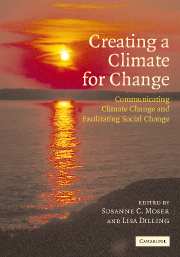Book contents
- Frontmatter
- Contents
- Preface
- Foreword
- List of contributors
- List of tables
- List of figures
- List of text boxes
- Introduction
- Part I Communicating climate change
- Part II Facilitating social change
- 15 Stuck in the slow lane of behavior change? A not-so-superhuman perspective on getting out of our cars
- 16 Consumption behavior and narratives about the good life
- 17 Educating for “intelligent environmental action” in an age of global warming
- 18 Education for global responsibility
- 19 Changing the world one household at a time: Portland's 30-day program to lose 5,000 pounds
- 20 Changing organizational ethics and practices toward climate and environment
- 21 Change in the marketplace: business leadership and communication
- 22 The market as messenger: sending the right signals
- 23 Making it easy: establishing energy efficiency and renewable energy as routine best practice
- 24 Forming networks, enabling leaders, financing action: the Cities for Climate Protection™ campaign
- 25 Ending the piecemeal approach: Santa Monica's comprehensive plan for sustainability
- 26 States leading the way on climate change action: the view from the Northeast
- 27 West Coast Governors' Global Warming Initiative: using regional partnerships to coordinate climate action
- 28 Building social movements
- 29 Climate litigation: shaping public policy and stimulating debate
- 30 The moral and political challenges of climate change
- Part III Creating a climate for change
- About the authors
- Index
- References
27 - West Coast Governors' Global Warming Initiative: using regional partnerships to coordinate climate action
Published online by Cambridge University Press: 20 August 2009
- Frontmatter
- Contents
- Preface
- Foreword
- List of contributors
- List of tables
- List of figures
- List of text boxes
- Introduction
- Part I Communicating climate change
- Part II Facilitating social change
- 15 Stuck in the slow lane of behavior change? A not-so-superhuman perspective on getting out of our cars
- 16 Consumption behavior and narratives about the good life
- 17 Educating for “intelligent environmental action” in an age of global warming
- 18 Education for global responsibility
- 19 Changing the world one household at a time: Portland's 30-day program to lose 5,000 pounds
- 20 Changing organizational ethics and practices toward climate and environment
- 21 Change in the marketplace: business leadership and communication
- 22 The market as messenger: sending the right signals
- 23 Making it easy: establishing energy efficiency and renewable energy as routine best practice
- 24 Forming networks, enabling leaders, financing action: the Cities for Climate Protection™ campaign
- 25 Ending the piecemeal approach: Santa Monica's comprehensive plan for sustainability
- 26 States leading the way on climate change action: the view from the Northeast
- 27 West Coast Governors' Global Warming Initiative: using regional partnerships to coordinate climate action
- 28 Building social movements
- 29 Climate litigation: shaping public policy and stimulating debate
- 30 The moral and political challenges of climate change
- Part III Creating a climate for change
- About the authors
- Index
- References
Summary
Introduction
The governors of California, Oregon, and Washington launched the West Coast Governors' Global Warming Initiative (WCGGWI) in 2003. In doing so, they joined the New England governors and Eastern Canadian premiers in addressing global warming from a state and regional perspective (see also Tennis, Chapter 26, this volume). The governors instructed their staff to look for strategies that mitigate greenhouse gas (GHG) emissions through measures that also promote long-term economic growth, protect public health and the environment, consider social equity issues, and expand public awareness of climate change. This chapter describes the West Coast regional effort and examines the ways in which local and state-level action have contributed to bringing about this regional initiative, and in turn, how the regionally integrated emission reduction initiative supports states and local communities in fulfilling and going beyond their own individual action plans.
Motivations for the West Coast Governors' Global Warming Initiative
The governors of California, Oregon, and Washington initiated the WCGGWI because they recognized that existing state and federal policies would not stabilize, much less begin reducing, the region's level of GHG emissions. The states also hoped to establish precedents that would spur the development and implementation of climate polices in other states and at the federal level.
In addition, the governors were motivated by the fact that global warming will have serious adverse consequences for the economy, public health, and the environment of West Coast states.
- Type
- Chapter
- Information
- Creating a Climate for ChangeCommunicating Climate Change and Facilitating Social Change, pp. 431 - 450Publisher: Cambridge University PressPrint publication year: 2007



